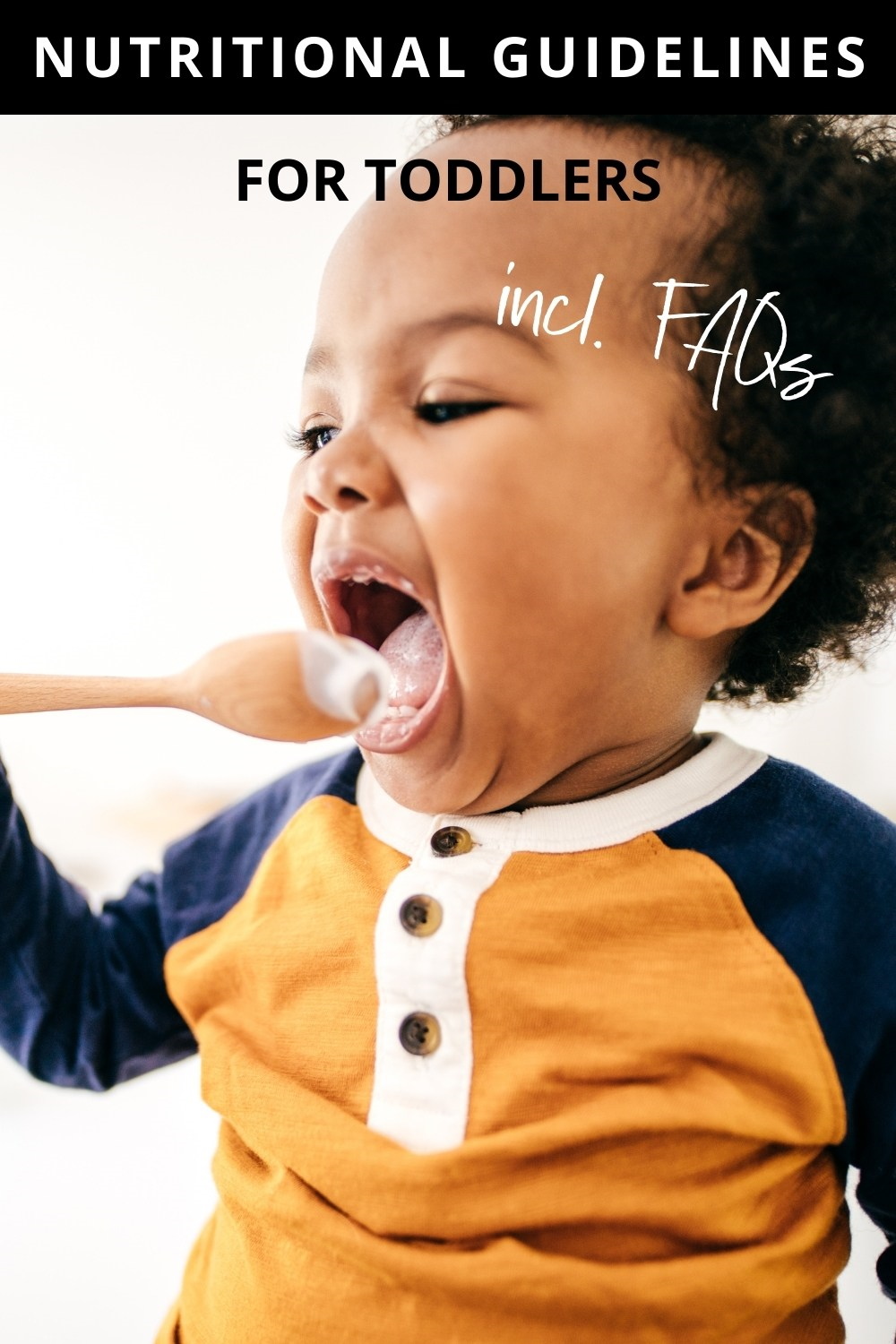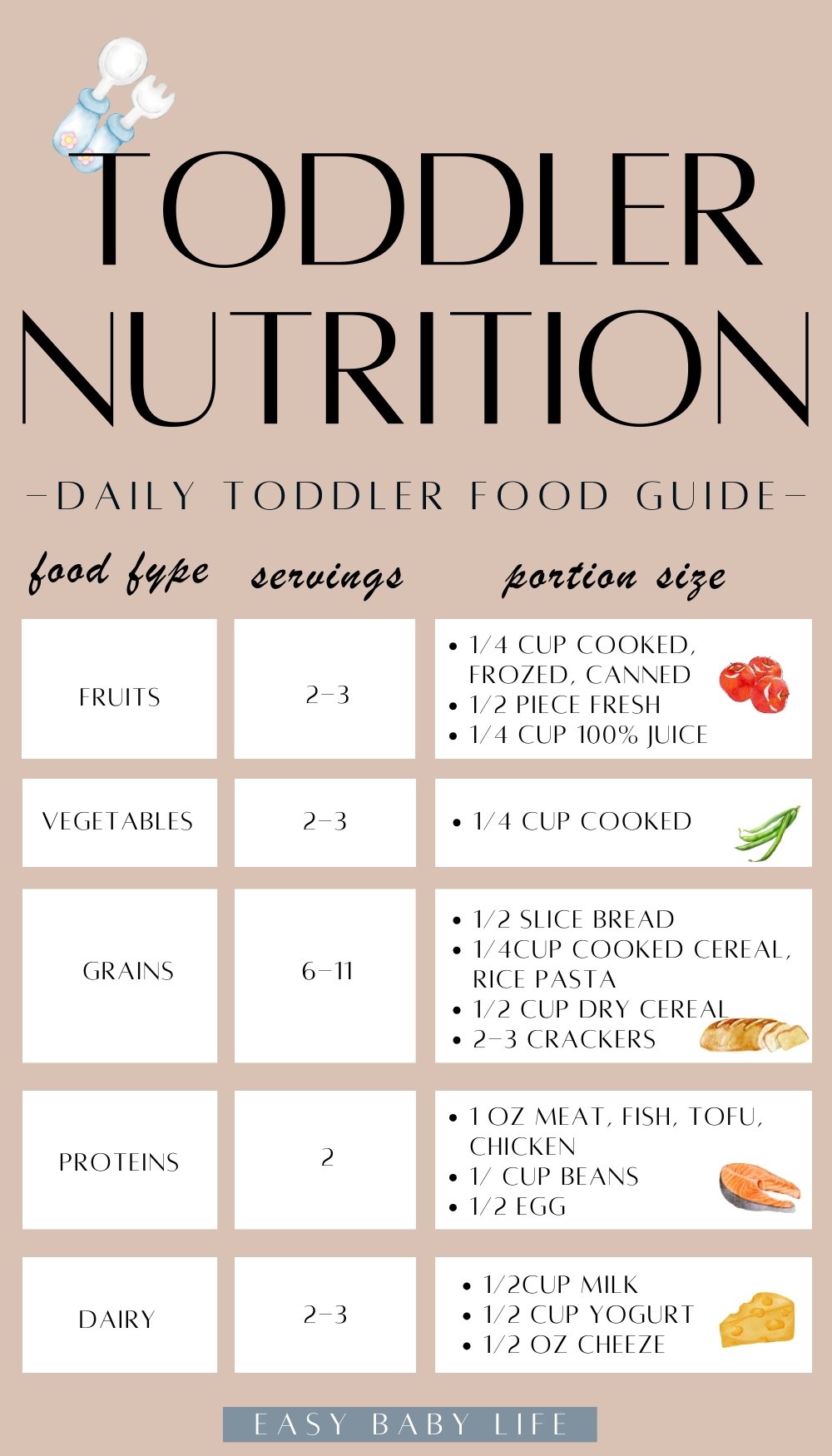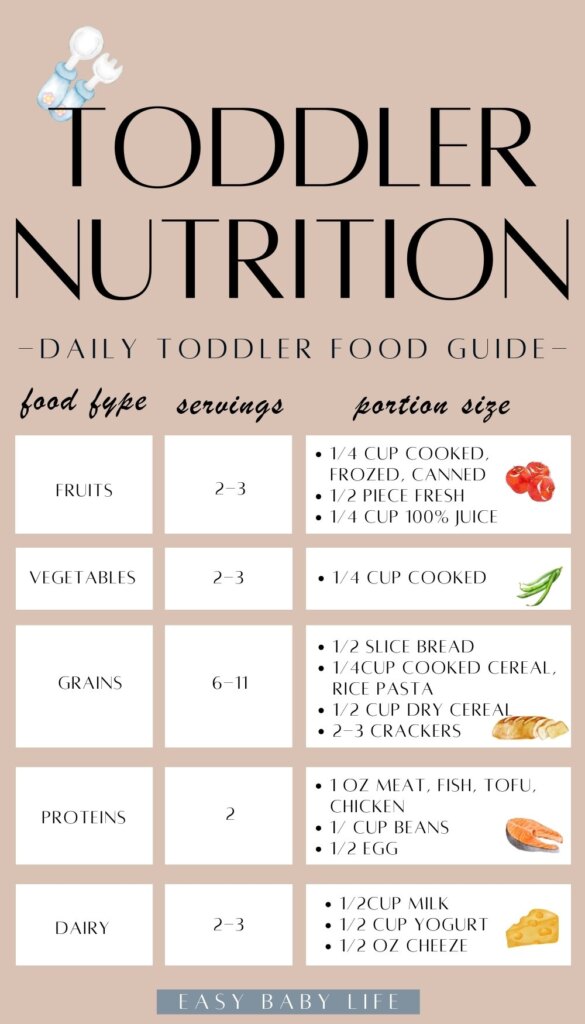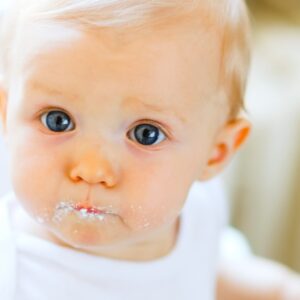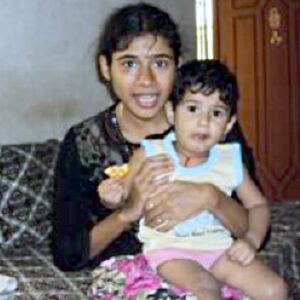Sitting down to eat isn’t a top priority for most toddlers. They are busy exploring their environments, and finding ways to grab whatever is within reach.
Parents often worry, “Is my child eating enough of the right foods?” or “What should my toddler eat to be healthy?”

By their first birthday, most kids are regularly eating mashed table foods and learning to manage chunkier textures. Infant formula is discontinued, and some infants are weaned from breastfeeding. Although there are fewer food restrictions, there are some safety concerns unique to this age group.
To further complicate things, eating habits and taste preferences may change. Toddler dietary needs pose the challenge of providing the right balance of nutrients while giving foods that are age appropriate.
Let’s go through the nutritional needs for toddlers and all the common questions parents have about feeding their toddlers.
FAQs, Guidelines, and Nutritional Needs for Toddlers
In this article:
Toddler Nutritional Challenges
Although some toddlers continue to eat the same variety of foods as they did as infants, many do not. For those who are no longer breastfeeding, the transition to whole cow’s milk can be particularly challenging. Kids who love it will drink as much as the parent or caregiver offers. Too much milk, however, can create the sensation of feeling “full” throughout the day, which limits food intake at meals. It may also cause constipation and iron deficiency anemia.
Toddlers may exhibit a preference for only a select group of foods, refusing to eat anything else that is offered. For example, a two-year-old who readily eats fruits, pasta, pizza, and chicken nuggets may cry or have a tantrum if offered a vegetable.
Parents may also notice that chewier textures, such as meat or chicken, are rejected because they require more effort to eat.
In other cases, some toddlers prefer to eat small snacks throughout the day but will refuse larger family meals. Further compounding this issue, many develop a preference for sweet-tasting foods at the expense of others.
Despite the best parental efforts, many toddlers fail to consume enough of the right nutrients. They eat limited amounts of the recommended healthy foods and choose ones that are high in salt and saturated fat. Toddler diets may also be low in fiber and vitamin D, which can affect gut and bone health. Limited fruit and vegetable intake can result in deficiencies of vitamins A, B group, and C.
With so many barriers, it is important for parents to be aware of a toddler’s nutritional needs.
Official Dietary Recommendations for Toddlers
Health authorities have presented nutritional guidelines in an effort to promote optimal toddler growth and development.
It is recommended that one to four year olds consume 1000 to 1400 calories per day. According to the American Academy of Pediatrics (AAP), these calories should be obtained from appropriately sized portions of fruits, vegetables, grains, proteins, and dairy.
Under age two, the World Health Organization considers breastmilk to be an important part of daily caloric intake. They also advise parents to offer three to four meals per day and one to two snacks.
The following is a sample daily diet from the AAP for one to three-year-olds:
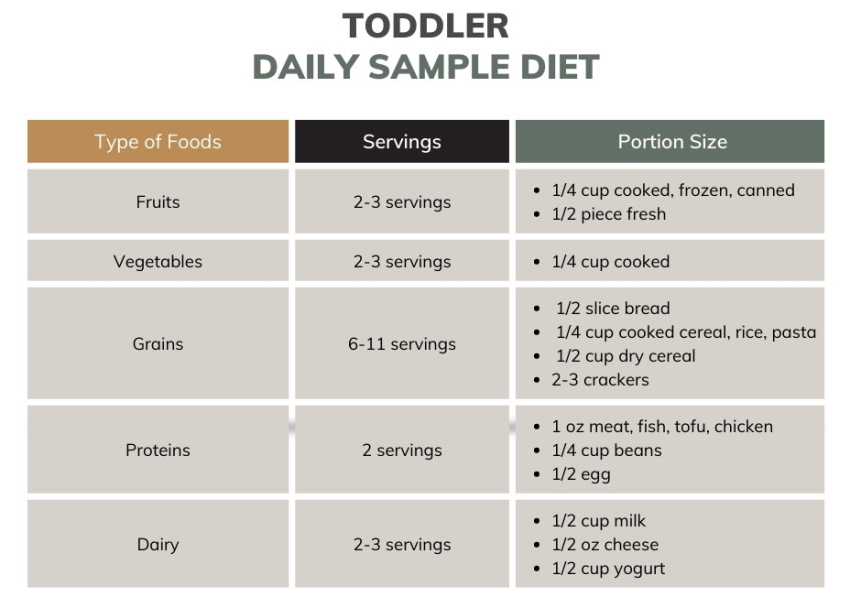
Looking at these guidelines, busy parents may cringe at the idea of measuring food for each meal.
It may be easier to think of a toddler portion as one-quarter the size of an adult one.
Specific Nutrients That Toddlers Need
Carbohydrates
These foods provide energy for all of the walking, climbing, and running that toddlers do. They also support brain function, especially during the early morning hours. Although refined pasta, rice, and bread are the usual choices, it is better for carbohydrates to be obtained from fruits, vegetables, legumes, and whole grains.
Protein
Protein is essential for muscles and the proper functioning of the glands and organs. It also provides energy. Common sources include meats, fish, chicken, eggs, soy, nuts, beans, cheese, and yogurt. Although low-fat versions are recommended for older children and adults, some fats are healthy for toddlers.
Vitamin D and Calcium
These two nutrients support healthy bones and teeth.
Calcium also plays a role in the proper functioning of the heart and body cells.
Vitamin D promotes calcium absorption from the intestines and into bones. It is also thought to support the immune system’s ability to fight infections and mitigate allergies. Whole milk is a good source of calcium and vitamin D, and is recommended until age two. Low-fat milk may be given to older toddlers.
Fortified cereals and plant-based milks are alternative sources. Other foods that have calcium include tofu, sesame seeds, kale, spinach, broccoli, and some fish.
Healthy Fats
Saturated fat from avocados, egg yolks, nuts, coconut, full-fat dairy, and oily fish is recommended to support toddler brain development. This fat assists in the formation of proper nerve connections within the brain. There is no nutritional benefit, however, to processed foods containing trans fats or unsaturated fats.
Read more about adding fat to baby and toddler food here.
Iron
Similar to fats, iron is also essential for brain development. Toddler diets that are low in iron can promote learning difficulties later in life. Good sources of iron include dark green leafy vegetables, broccoli, tofu, meats, poultry, fish, beans, peas, nuts, and fortified breads.
Iron-rich foods including recipes for toddlers, can be found here.
Considerations for Toddlers with Food Allergies or Plant-based Diets
Some toddlers are allergic to cow’s milk and develop reactions to dairy-based cheese, yogurt, and other products.
There are also families who prefer vegetarian or vegan diets.
In these situations, soy milk is the recommended alternative to cow’s milk, especially under the age of two. This is because the protein and fat content is higher than in other plant-based milks, which is important for toddler brain development. Tofu is another good source of protein and calcium.
For toddlers who are allergic to wheat, gluten-free grains are recommended. Parents should choose whole grain oats and corn products or wild rice for higher nutrient content.
Kids with other types of food allergies should avoid the offending foods as recommended by their pediatrician or allergist (i.e. nuts, eggs).
Foods That Should Be Avoided
Processed foods are often high in salt and sugar and, thus, should be avoided. Because of the negative effects on heart and kidney health, the FDA has asked food manufacturers and restaurant owners to reduce the salt content of their offerings.
Although juice is an everyday kid favorite, whole fruits provide more nutrition and less sugar. Sugary foods and beverages lead to obesity and tooth decay.
How well a toddler has mastered chewing should also be considered. Dietary modifications may be necessary to make foods safer and easier to eat. Some 12-month-olds may only have their first two primary teeth. These teeth enable biting into foods but aren’t always effective for chewing.
Molars begin to erupt between 14 to 18 months old, and teething continues until age two. Sore gums can make eating uncomfortable, so soft textured foods are more appropriate during this time. For example, silken tofu and ground meats may be better tolerated while teething.
In addition, some foods are choking hazards for toddlers. Smooth-surfaced, round fruits and hard candies can easily lodge into a toddler’s airway. Chunky pieces of meats, hard cheeses, and uncooked vegetables are also a choking risk.
To prevent a life-threatening accident, fruits the size of a cherry or smaller should be cut into quarters before serving. Whole nuts and popcorn should be avoided. The skins or casings of hotdogs, sausages, and similar foods should be removed.
“Gummies” are very popular versions of kid fruit snacks, candies, and vitamins. However, their sticky texture is both a choking hazard and a cause of dental problems.
Frequently Asked Questions About Toddler Nutrition
Is rice ok for toddlers to eat?
There is a growing concern about the arsenic content of rice throughout the world. This contaminant may be present in the soil or water where rice grows. Excessive ingestion of arsenic is associated with some types of cancer.
Although there are new rice farming efforts to keep arsenic levels low, it is likely that much of what is sold in markets and grocery stores contains amounts of it.
Completely avoiding rice, however, may not be feasible or culturally acceptable. In response to concerns, the FDA has determined that ingestion of 100 ppb of arsenic daily does not increase health risks. Parents, however, should offer toddlers a variety of other foods to limit this exposure.
Do Toddlers Need Meat?
No. There are many other foods that can provide protein, iron, and other nutrients found in meat. These include nuts, seeds, beans, peas, eggs, cheese, yogurt, soy products, fish, and poultry. Wheat, corn, rice, and barley are significant grain sources of protein, as well as buckwheat and quinoa.
Can a Two-Year-Old Have an Eating Disorder?
No. An eating disorder is a psychological condition characterized by a distorted perception of food and/or body image. Two-year-olds have not yet acquired the level of cognitive development necessary to make such judgments about food or themselves.
The youngest reported cases of eating disorders are between eight and nine years old.
How Much Milk Should a Toddler Drink?
Too much milk may discourage a toddler from eating at mealtime and cause iron deficiency anemia. 20 ounces of milk per may be appropriate for a 12-month-old, but this amount should be reduced over time.
Seven to 14 ounces (200 to 400 mL) of milk per day provides the recommended amount of nutrients for most toddlers.
How Can I Fatten Up My Skinny Toddler?
Extended relatives and other caregivers may comment that a toddler is “too skinny.” They compare the child to other kids of the same age or how he or she appeared as an infant.
If there is a concern, parents should first discuss this with their pediatrician. The child’s height and weight should be measured and plotted on standardized growth charts. After doing so, many parents realize that their child’s weight is normal and proportional to their height.
When a toddler is underweight, however, it may be a sign of an underlying medical problem and unrelated to caloric intake. An evaluation for thyroid disease, type I diabetes, or a heart problem may be warranted. In other cases, the child may have a food allergy or gastrointestinal disorder that prevents proper absorption of nutrients.
Once the correct diagnosis has been determined, a dietary plan should be developed that helps the child gain an appropriate amount of weight. Although there are a variety of beverages and toddler formulas marketed for growth and weight gain, these should not be included in the diet unless directed by a doctor. The AAP does not recommend toddler formulas. These products and most “nutritional drinks” are high in sugar.
What Can I Feed My Overweight Toddler?
Even if growth charts indicate that a toddler is overweight, it is still important to offer a variety of fruits, vegetables, proteins, and whole-grain carbohydrates. Every child is different, however, so a customized meal plan should be discussed with a pediatrician or nutritionist.
In general, toddlers are not “put on diets,” because of concern for restricting essential nutrients. Focusing on lifestyle modifications such as stress reduction, more physical activity, and adjusting eating behaviors within the family is often more successful.
Do Toddlers Need Milk In the Middle of the Night?
No. Toddlers who have eaten two to three meals plus snacks during the daytime hours have no nutritional need for milk during the night. Offering it when a child wakes can reduce the desire to eat breakfast the next morning because the toddler is “already full.” Because most parents do not brush their child’s teeth after drinking middle of the night milk, it also increases the risk of tooth decay.
Read Next About Feeding Toddlers
- Food Power Struggle With Your Child? 12 Tips to Avoid It!
- Toddler Refuses to Eat: Great Alternatives to Forcefeeding!
- 7 Tips If Your Toddler Stopped Eating; Choose Fun over Fight!
- 21 Vital Tips For Dining Out With a Toddler and Love It!
Research References
- The Consequence of Excessive Consumption of Cow’s Milk: Protein-Losing Enteropathy with Anasarca in the Course of Iron Deficiency Anemia
- The Feeding Infants and Toddlers Study (FITS) 2016: Moving Forward
- Nutrition and Hydration Requirements In Children and Adults
- Vitamin D in Toddlers, Preschool Children, and Adolescents
- The Role of Nutrition in Brain Development: The Golden Opportunity of the “First 1000 Days”

Paula Dennholt founded Easy Baby Life in 2006 and has been a passionate parenting and pregnancy writer since then. Her parenting approach and writing are based on studies in cognitive-behavioral models and therapy for children and her experience as a mother and stepmother. Life as a parent has convinced her of how crucial it is to put relationships before rules. She strongly believes in positive parenting and a science-based approach.
Paula cooperates with a team of pediatricians who assist in reviewing and writing articles.

